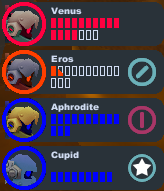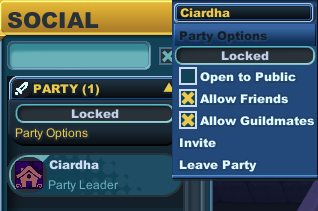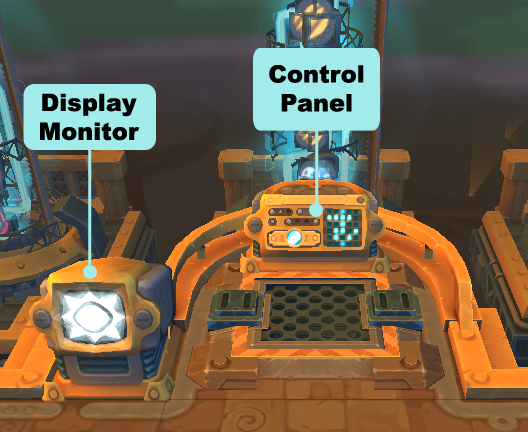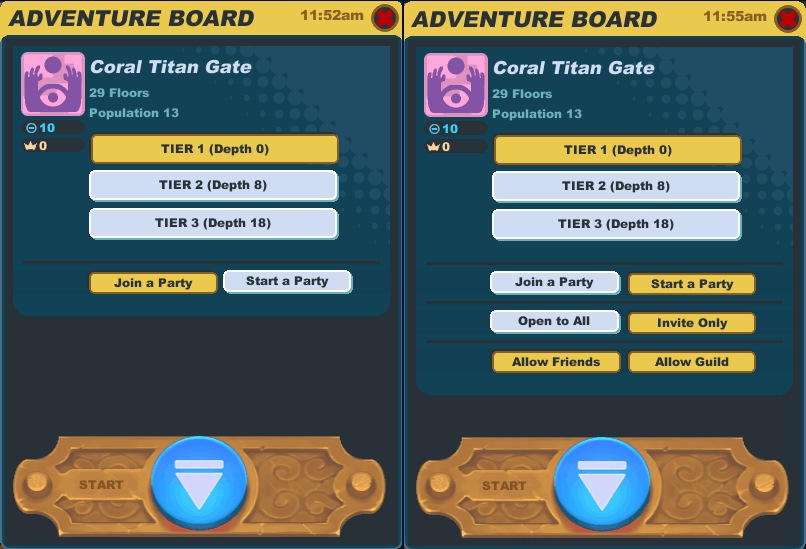Difference between revisions of "Party"
From SpiralKnights
m (→Equipment Locking) |
(small cleanups; I think I'm done with this article for a while) |
||
| (23 intermediate revisions by 13 users not shown) | |||
| Line 1: | Line 1: | ||
| − | [[File:Party | + | [[File:Party energy.png|thumb|right|Party members as they appear in the party menu.]] |
| − | + | ||
| − | + | A '''party''' is a group of 1-4 knights adventuring in a gate or mission. The knights collaborate to kill monsters and solve puzzles. Almost all of their treasure is shared. While in the [[Clockworks]], [[chat]] defaults to /party, allowing communication with everyone in the party, regardless of distance. | |
| − | + | [[File:Party-Leader_Menu.png|thumb|left|The party menu while on an adventure.]] | |
| − | + | The party menu is the user interface for inspecting and managing party members. The party menu can be accessed in the top left corner of the screen, near the knight's portrait. | |
| + | |||
| + | {{clearright}} | ||
| + | |||
| + | == Forming a Party == | ||
| + | |||
| + | === Starting === | ||
| − | |||
[[Image:Gates-active_platform.png|thumb|right|The parts of an active gate platform include: The control panel and display monitor showing the gate symbol.]] | [[Image:Gates-active_platform.png|thumb|right|The parts of an active gate platform include: The control panel and display monitor showing the gate symbol.]] | ||
| − | |||
| − | + | You can start a party by going to an active [[gate]] in the [[Arcade]], standing in front of the control panel and using the "Attack" button. Alternatively, you can start a party in the Arcade part of the Mission interface. | |
| + | |||
| + | You must choose which [[Clockworks|tier]] to start in. Some tiers may be grayed out, if the [[Spiral Warden]] does not deem you experienced enough to travel to that tier. | ||
| − | + | You must also choose one of these three options: | |
| + | * '''Create Public Party''': Anyone in the game will be permitted to join your party. | ||
| + | * '''Create Private Party''': Only friends and guild members will be permitted to join. | ||
| + | * '''Play Solo''': No one will be permitted to join. Use this option if you wish to play alone. | ||
| + | After starting your party, you can change the access permissions in the party menu. | ||
| − | |||
{{clearright}} | {{clearright}} | ||
| − | |||
| − | |||
| − | + | === Joining === | |
| − | + | [[File:Party-Lobby_Menu.png|thumb|350px|right|Joining an existing party (left), and creating a party (right). Note that some options may not appear if you select certain other options.]] | |
| − | + | There are several ways to join parties that already exist: | |
| + | * One process is similar to that for starting a new party. You can join a party by going to an active gate in the [[Arcade]] or using the Arcade part of the Mission interface. | ||
| + | * The [[Party Finder]] interface helps you inspect the parties that are available. | ||
| + | * If a friend or guildmate is in a party that allows friends, guildmates, or everyone to join, then you can join by clicking on that knight in your Social interface. | ||
| + | * If someone specifically invites you to join their party, then the party invitation will appear on the right side of your user interface. | ||
| − | + | Some tiers of the Clockworks may be inaccessible to you, if you lack the clearance to access them. However, an invitation lets you bypass these access restrictions. | |
| − | + | ||
| − | + | A party cannot be joined in certain levels of the Clockworks: [[Treasure Vault]]s, [[Treasure Trove]]s, [[Boss]] levels, Shadow Lairs, and levels of danger missions after the first level. Additionally, someone who has started a party by going solo cannot be immediately joined, and a party cannot be joined when a party member that went solo returns. | |
| − | + | ||
| − | + | ||
| − | == | + | === Inviting === |
| − | + | ||
| − | + | The party leader can invite any knight to join the party. If the leader allows it, any party member can invite knights. | |
| − | + | ||
| − | + | ||
| − | + | As was mentioned above, these invitations bypass tier clearances, but they do not work in certain high-reward levels. | |
| − | + | ||
| − | == | + | === Leaving === |
| − | + | ||
| − | + | At any time, any knight in a party may choose to leave the party. There are two mechanisms. | |
| − | + | First, the knight can choose to return to Haven (or quit the Spiral Knights application entirely). | |
| − | + | ||
| − | + | ||
| − | + | Second, the knight can choose to "Go Solo" in the party menu. The knight finds themself the leader of a party of one, starting from exactly where they went solo. That is, the gate, level, party buttons, etc. are all exactly as they were before the knight went solo. Any heat gained on the level thus far is lost. Treasure left on the floor is erased. Other knights are not allowed to join the new party immediately. | |
| − | + | === Removing === | |
| − | + | The party leader can remove party members for any reason. The effect is the same as if the removed member went solo. | |
| − | + | Additionally, if the party member has violated the [[Terms of Service]] or [[Community Standards]], then the leader or other members can file a [[complain]]t. | |
| − | + | == Effect on Gameplay == | |
| − | + | Spiral Knights is designed to be a cooperative game. The rules of parties are designed to encourage collaboration rather than competition. | |
| − | + | === Combat === | |
| − | + | When there are multiple knights in a party, the monsters faced are somewhat more difficult. Against a one-knight party, each monster has a set "baseline" health. Each additional party member increases the monster's health by about 1/3 of its baseline. So monsters have twice as much health against a party of four as against a party of one. In a [[Graveyard]] there is always one [[Phantom]] per knight, and in [[Candlestick Keep]] there is always one [[Grimalkin]] per knight. | |
| − | + | Knights traveling together can benefit from teamwork: | |
| + | * The damage from multiple knights usually outweighs the monsters' extra health. | ||
| + | * Knights can [[reviving|revive]] fallen comrades using [[Rarity#Spark of Life|Sparks of Life]] (in the party menu). | ||
| + | * As long as at least one knight makes it through the level to the lift, the entire party makes it through the level. If the surviving knight goes down at the lift, then all party members go down. The fallen party members do not gain heat from the level, and will automatically use their Emergency Revive upon beginning the next depth. | ||
| + | * By having multiple knights, the party can in aggregate have a more varied assortment of weapons. For example, the party can have swords dealing multiple kinds of damage, guns dealing multiple status effects, etc. | ||
| + | * There are various other tactical advantages. For example, a knight can free a comrade trapped in a block of [[freeze|ice]], and one knight can lure a monster while another knight attacks it from behind. | ||
| − | + | Some knights prefer to travel alone, sometimes because party play can cause chaos: | |
| + | * Monsters can shift their focus from one target to another, making those monsters harder to predict and manage. | ||
| + | * Shield bumps and weapon knockback can move and disrupt monsters. For example, a monster can aim its attack at one knight, get knocked back by a [[Nitronome]] blast, and then hit a different knight. | ||
| + | * Many levels have switches to toggle traps or doors. In a party, careless knights often kill each other switching them while someone is trying to safely get past. | ||
| + | * Some levels have puzzles that can make loot become inaccessible. In a party it is more likely someone isn't careful and the treasure is lost to all. | ||
| − | + | ===Treasure=== | |
| − | + | When a monster is killed or a treasure box is opened, various kinds of [[pickup]]s, [[heat]], and treasure spill onto the floor. Each party member gets their own randomly generated copy of this loot and is responsible for picking it up for themself. It is worth noting that heat is applied to the knight's equipment only when the level is completed. | |
| − | + | ||
| − | + | ||
| − | + | ||
| − | + | ||
| − | + | ||
| − | + | Each party member may carry one [[mineral]] at a time. Like heat, minerals are permanently applied to the knight's inventory only when the level is completed. At that time, every party member gets a copy of every mineral carried by the party. Therefore, knights playing with other knights can earn minerals much more rapidly than knights who adventure alone. | |
| − | + | ||
| + | There are other economic advantages to party play. An energy door (to a [[danger room]] or extra treasure room) requires payment from only one knight in the party. Unlocking a [[Shadow Lair]] gate requires only one Shadow Key per party. | ||
== See Also == | == See Also == | ||
*[[Exploration]] | *[[Exploration]] | ||
| − | * | + | |
| − | * | + | ==Other links== |
| + | *{{de|Gruppen}} | ||
| + | *{{es|Grupo}} | ||
| + | *{{fr|Groupe}} | ||
| + | |||
[[Category:Terminology]][[Category:Combat]] | [[Category:Terminology]][[Category:Combat]] | ||
Latest revision as of 11:18, 10 March 2020
A party is a group of 1-4 knights adventuring in a gate or mission. The knights collaborate to kill monsters and solve puzzles. Almost all of their treasure is shared. While in the Clockworks, chat defaults to /party, allowing communication with everyone in the party, regardless of distance.
The party menu is the user interface for inspecting and managing party members. The party menu can be accessed in the top left corner of the screen, near the knight's portrait.
Contents
Forming a Party
Starting
You can start a party by going to an active gate in the Arcade, standing in front of the control panel and using the "Attack" button. Alternatively, you can start a party in the Arcade part of the Mission interface.
You must choose which tier to start in. Some tiers may be grayed out, if the Spiral Warden does not deem you experienced enough to travel to that tier.
You must also choose one of these three options:
- Create Public Party: Anyone in the game will be permitted to join your party.
- Create Private Party: Only friends and guild members will be permitted to join.
- Play Solo: No one will be permitted to join. Use this option if you wish to play alone.
After starting your party, you can change the access permissions in the party menu.
Joining
There are several ways to join parties that already exist:
- One process is similar to that for starting a new party. You can join a party by going to an active gate in the Arcade or using the Arcade part of the Mission interface.
- The Party Finder interface helps you inspect the parties that are available.
- If a friend or guildmate is in a party that allows friends, guildmates, or everyone to join, then you can join by clicking on that knight in your Social interface.
- If someone specifically invites you to join their party, then the party invitation will appear on the right side of your user interface.
Some tiers of the Clockworks may be inaccessible to you, if you lack the clearance to access them. However, an invitation lets you bypass these access restrictions.
A party cannot be joined in certain levels of the Clockworks: Treasure Vaults, Treasure Troves, Boss levels, Shadow Lairs, and levels of danger missions after the first level. Additionally, someone who has started a party by going solo cannot be immediately joined, and a party cannot be joined when a party member that went solo returns.
Inviting
The party leader can invite any knight to join the party. If the leader allows it, any party member can invite knights.
As was mentioned above, these invitations bypass tier clearances, but they do not work in certain high-reward levels.
Leaving
At any time, any knight in a party may choose to leave the party. There are two mechanisms.
First, the knight can choose to return to Haven (or quit the Spiral Knights application entirely).
Second, the knight can choose to "Go Solo" in the party menu. The knight finds themself the leader of a party of one, starting from exactly where they went solo. That is, the gate, level, party buttons, etc. are all exactly as they were before the knight went solo. Any heat gained on the level thus far is lost. Treasure left on the floor is erased. Other knights are not allowed to join the new party immediately.
Removing
The party leader can remove party members for any reason. The effect is the same as if the removed member went solo.
Additionally, if the party member has violated the Terms of Service or Community Standards, then the leader or other members can file a complaint.
Effect on Gameplay
Spiral Knights is designed to be a cooperative game. The rules of parties are designed to encourage collaboration rather than competition.
Combat
When there are multiple knights in a party, the monsters faced are somewhat more difficult. Against a one-knight party, each monster has a set "baseline" health. Each additional party member increases the monster's health by about 1/3 of its baseline. So monsters have twice as much health against a party of four as against a party of one. In a Graveyard there is always one Phantom per knight, and in Candlestick Keep there is always one Grimalkin per knight.
Knights traveling together can benefit from teamwork:
- The damage from multiple knights usually outweighs the monsters' extra health.
- Knights can revive fallen comrades using Sparks of Life (in the party menu).
- As long as at least one knight makes it through the level to the lift, the entire party makes it through the level. If the surviving knight goes down at the lift, then all party members go down. The fallen party members do not gain heat from the level, and will automatically use their Emergency Revive upon beginning the next depth.
- By having multiple knights, the party can in aggregate have a more varied assortment of weapons. For example, the party can have swords dealing multiple kinds of damage, guns dealing multiple status effects, etc.
- There are various other tactical advantages. For example, a knight can free a comrade trapped in a block of ice, and one knight can lure a monster while another knight attacks it from behind.
Some knights prefer to travel alone, sometimes because party play can cause chaos:
- Monsters can shift their focus from one target to another, making those monsters harder to predict and manage.
- Shield bumps and weapon knockback can move and disrupt monsters. For example, a monster can aim its attack at one knight, get knocked back by a Nitronome blast, and then hit a different knight.
- Many levels have switches to toggle traps or doors. In a party, careless knights often kill each other switching them while someone is trying to safely get past.
- Some levels have puzzles that can make loot become inaccessible. In a party it is more likely someone isn't careful and the treasure is lost to all.
Treasure
When a monster is killed or a treasure box is opened, various kinds of pickups, heat, and treasure spill onto the floor. Each party member gets their own randomly generated copy of this loot and is responsible for picking it up for themself. It is worth noting that heat is applied to the knight's equipment only when the level is completed.
Each party member may carry one mineral at a time. Like heat, minerals are permanently applied to the knight's inventory only when the level is completed. At that time, every party member gets a copy of every mineral carried by the party. Therefore, knights playing with other knights can earn minerals much more rapidly than knights who adventure alone.
There are other economic advantages to party play. An energy door (to a danger room or extra treasure room) requires payment from only one knight in the party. Unlocking a Shadow Lair gate requires only one Shadow Key per party.



